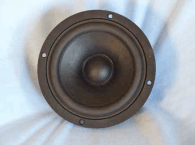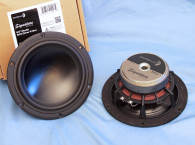

Wavecor’s 4Ω WF182BD13 (the WF182BD14 being the 8Ω version) midbass driver has a generous feature set that includes a proprietary eight-spoke cast-aluminum frame (Photo 3). As with many high-end midbass drivers, the spokes are narrow (10mm wide) and provide minimum reflections into the rear cone surface, plus the frame is substantially open below the spider (damper) mounting shelf for voice coil cooling.

Other features, in addition to the new carbon fiber/Kevlar cone material, include a vented inverted dome-type phase plug (no dust cap), which I admit, I have not encountered previously. For compliance, the WF182BD13 has a shallow profile low loss high Qm NBR surround, accompanied by a flat 4” diameter black cloth spider.
All of this is driven by a 32mm (1.25”) diameter two-layer voice coil wound with round copper wire on a vented black fiber glass non-conducting former. The Wavecor balanced driver T-pole motor system powering the cone assembly utilizes a 20mm thick 120mm diameter ferrite magnet sandwiched between a black emissive-coated 5mm thick front plate and a black emissive coated and shaped T-yoke that incorporates a flared 10mm diameter pole vent for additional cooling. The WF182BD13 further incorporates a set of dual shorting rings (a copper pole cap and an aluminum ring at the base of the pole) that reduce distortion caused by eddy currents. Last, the braided voice coil lead wires terminate to a pair of gold-plated solderable terminals.
I began characterizing the new WF182BD13 7” midbass woofer using the LinearX LMS analyzer and the Physical LAB IMP Box (same type of test fixture as a LinearX VI Box for measuring voltage and current separately). Sweeps were generated with the driver securely mounted in free air at 0.3V, 1V, 3V, 6V, 10V, and 15V. The measured Mmd that was provided by Wavecor (an actual physical cone assembly measurement with 50% of the surround and spider removed) was used rather than a single 1V added (delta) mass measurement.
It should also be noted that this multi-voltage parameter test procedure included heating the voice coil between sweeps for progressively longer periods to simulate operating temperatures at that voltage level (raising the temperature to the first- and second-time constants). The 15V curves were too nonlinear to get a sufficient curve fit and were discarded. The remaining 10 stepped sine wave sweeps for each woofer were further processed with the voltage curves divided by the current curves to produce impedance curves.
Phase curves were generated using the LEAP phase calculation routine, after which the impedance magnitude and phase curves plus the associated voltage curves were copy/pasted into the LEAP 5 Enclosure Shop software’s Guide Curve library. This data was then used to calculate parameters using the LEAP 5 LTD transducer model. Because most all manufacturing data is being produced using either a standard transducer model or in many cases the LEAP 4 TSL model, I also generated LEAP 4 TSL model parameters using the 1V free-air that can also be compared with the manufacturers data.

Figure 1 shows the WF182BD13’s 1V free-air impedance plot. Table 1 compares the LEAP 5 LTD and LEAP 4 TSL Thiele-Small (T-S) parameter sets for the Wavecor WF182BD13 midbass driver samples along with the Wavecor factory data.

From the comparative data shown in Table 1, you can see that all four parameter sets for the two samples were reasonably similar and correlated rather well with the factory data. The only variant was sensitivity and happens because mine is a result of T-S parameter calculation while Wavecor averages measured SPL from 300Hz to 1kHz at 2.83V/1m.
Following my normal protocol for Test Bench testing, I used the Sample 1 LEAP 5 LTD parameters and set up two computer box simulations, one in a 0.14ft3 Butterworth-type sealed enclosure (Qtc=0.7) with 50% fill material (fiberglass). The second simulation was a vented Extended Bass Shelf (EBS) alignment in a 0.49ft3 box with 15% fill material and tuned to 37.49Hz. This is a fairly low tuning for this size enclosure, so using one of Wavecor’s passive radiators would actually be a better choice than a port tube or slot type vent.
Figure 2 gives the enclosure simulation results for the WF182BD13 in the sealed and vented enclosures at 2.83V and at a voltage level sufficiently high enough to increase cone excursion to Xmax+15% (6.33mm for WF182BD13). This resulted in an F3 of 104Hz (-6dB=82Hz) with a Qtc=0.67 for the 0.14ft3 closed box and a -3dB for the vented simulation of 51Hz (-6dB=45Hz). Increasing the voltage input to the simulations until the approximate Xmax+15% maximum linear cone excursion point was reached resulted in 112dB at 29V for the sealed enclosure simulation and 111dB with a 24V input level for the larger vented box. Figure 3 shows the 2.83V group delay curves and Figure 4 shows the 29V/24V excursion curves.



This month, Jason Cochrane at Warkwyn performed the Klippel analysis for the Wavecor 7” midbass woofer by using the Klippel KA3 analyzer, which produced the Klippel data graphs given in Figures 5-8. If you do not own a Klippel analyzer and would like to generate this type of data on any transducer, Warkwyn can perform this and a myriad of other measurement and design consulting services.
The Bl(x) curve for WF182BD13 (Figure 5) is moderately broad and symmetrical typical of a 6.5” to 7” woofer. Looking at the Bl symmetry curve (Figure 6) shows a negligible 0.23mm Bl coil-out (forward) offset once you reach an area of reasonable certainty around 4mm, decreasing to 0.10mm at the physical 5.5mm Xmax.


Figure 7 and Figure 8 show the Kms(x) and Kms symmetry curves for the Wavecor midbass. Like the Bl curve, the Kms stiffness of compliance curve (Figure 7) is also very symmetrical, with only a minor offset. The Kms symmetry range curve (Figure 8) likewise indicates a negligible 0.19mm coil-out (forward) offset once you reach an area of reasonable certainty around 4mm, decreasing to 0.06mm at the physical 5.5mm Xmax.


Displacement limiting numbers, calculated by the Klippel analyzer for the WF182BD13 using the subwoofer criteria for Bl, was XBl at 82% (Bl dropping to 82% of its maximum value) equal to 5.39mm for the prescribed 10% distortion level (the criterion for full-range drivers). For the compliance, XC at 75% Cms minimum was 3.97mm, which means that for the Wavecor 7” woofer, the compliance is the more limiting factor for getting to the 10% distortion level. If we use the more conservative 20% distortion criteria, which several practitioners I know think is appropriate for midbass drivers as well as subwoofers, then the displacement limit numbers are XBl=6.72mm and XC=6.27, both numbers are greater than the physical Xmax of the WF182BD13.
Figure 9 gives the inductance curve Le(x) f. Motor inductance will typically increase in the rear direction from the zero-rest position as the voice coil covers more of pole, however that doesn’t happen here because of dual shorting ring configuration. What we do get is lower inductance variation from full in to full out travel, which is the goal. It’s easy to see the benefit of the dual shorting rings with inductance only varying about 0.007mH to 0.006mH from Xmax in to Xmax out, which is very minimal inductance change and indicates excellent inductive performance.

With the Klippel testing completed, I mounted the WF182BD13 woofer in a foam-filled enclosure that had a 12”×8” baffle and then measured the device under test (DUT) using the Loudsoft FINE R+D analyzer and the GRAS 46BE microphone (courtesy of Loudsoft and GRAS Sound & Vibration) both on- and off-axis from 200Hz to 20kHz at 2V/0.5m, normalized to 2.83V/1m using the cosine windowed FFT method.
Figure 10 gives the WF182BD13’s on-axis response, indicating a smooth rising response from 300Hz to 4.6kHz with some minor peaking centered on 1kHz. Figure 11 displays the on- and off-axis frequency response at 0°, 15°, 30°, and 45°, showing the typical directivity for a 6.5” to 7” woofer. The -3dB at 30° with respect to the on-axis curve occurs at about 2.3kHz, so is a reasonable frequency for a low-pass crossover. The normalized version of Figure 11 is given in Figure 12. Figure 13 shows the CLIO polar plot (in 10° increments and 1/3 octave smoothing). And finally, Figure 14 displays the two-sample SPL comparisons for the 10.75” Wavecor driver, showing a very close match ≤0.30dB throughout the operating range.





For the last remaining tests, I again employed the Listen, Inc. SoundCheck AudioConnect analyzer and SCM ¼” microphone to measure distortion and generate time-frequency plots.
For the distortion measurement, I mounted the 7” WF182BD13 driver rigidly in free air and set the SPL to 94dB at 1m (4.04V) using a pink noise stimulus. I then measured the distortion with the Listen microphone placed 10cm from the driver, which produced the distortion curves shown in Figure 15, with third-harmonic distortion staying between 0.2% to 0.3% from 300Hz to 4.5kHz.

I then used SoundCheck to get a 2.83V/1m impulse response for this driver and imported the data into Listen’s SoundMap Time/Frequency software. The resulting cumulative spectral decay (CSD) waterfall plot is given in Figure 16. And, Figure 17 shows the Wigner-Ville plot (chosen for its better low-frequency performance).


Given the data collected, along with the introduction of a new carbon fiber/Kevlar cone type, and the consistently good performance exhibited by Wavecor woofers, midranges, and tweeters, the WF182BD13 looks like an excellent addition to Wavecor’s lineup.
Needless to say, the Wavecor drivers characterized in our Test Bench articles are from Wavecor’s catalog line, however the company also does custom OEM drivers. For more information, visit www.wavecor.com. VC
This article was originally published in Voice Coil, August 2023.







